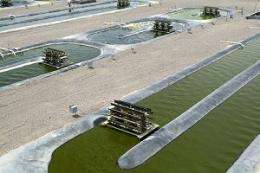Novel combination ensures entire solar spectrum harnessed

Murdoch University researchers have dramatically increased the conversion efficiency of solar energy by the novel pairing of algae biomass and selective thin film solar panels.
By modelling different translucent solar panel wavelength absorbencies and situating algae ponds beneath the panels, researchers were able to find algae species which thrived in the resulting 'unused' solar spectrum.
Photosynthesis only uses part of the solar spectrum within the range of 400–700nm (mostly blue and red spectrum) and translucent solar panels can be designed to absorb the spectrum outside these parameters to produce electricity.
Algae R&D Centre and School of Veterinary and Life Science's Dr Navid Moheimani says while the purpose of the design is to capture the entire light spectrum, a secondary outcome was also a reduction in algae pond evaporation.
"Considering the shortage of freshwater in WA, we can only use seawater in our algae cultivation ponds for filling the pond and evaporative make up," he says.
The solar panels and ponds are likely to be situated in WA's north-west, one of the world's best areas for solar production, however evaporation rates average at 3200mm per year.
"Evaporation will result in an increase in salinity over time [100 days to increase the salinity by four-fold in the pond] and limit the number of potential species for cultivation.
"[Hence] being able to control this by removing infra red light would allow us to grow several other species of microalgae."
Researchers were also able to model different solar-algae configurations, like using produced electricity to make up the essential red portion of the solar spectrum with LED lighting—this increasing the biomass potential by 16.5 per cent.
By making dual use for energy production per unit of land, it is hoped the biomass created can provide feedstock, biofuel or even food for human consumption.
Dr Moheimani says while it will take more research and development to find algae-appropriate wavelength absorbencies for solar panels, it could soon replace other production systems.
"Suitably tailored thin film photovoltaic devices [or collectors] could also be used in solar greenhouses or even market gardens."
"By only converting the parts of the solar spectrum not required by the algae [or plants] into electricity, the biomass would continue to grow," he says.
Dr Moheimani envisages in the next three-to-five years the research team will have a prototype ready for the market.
Provided by Science Network WA

















